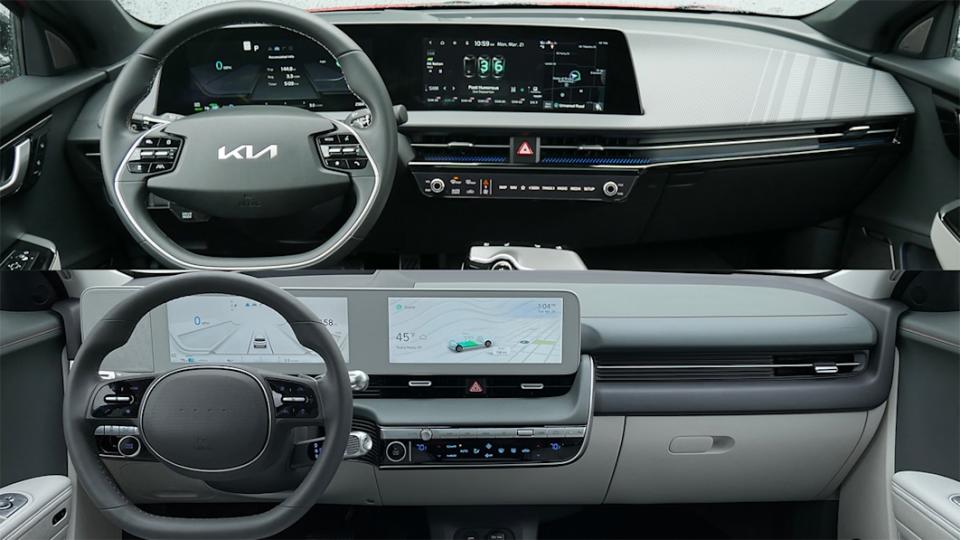Hyundai Ioniq 5 vs Kia EV6 Interior Comparison | Mellow modernism vs. supreme sportiness

Though mechanically extremely similar, the Hyundai Ioniq 5 and Kia EV6 are surprisingly different. A primary area where they differ is their interiors. And seeing as this is where you'll spend the vast majority of time with each vehicle, it's important to know which suits you best. So we've spent some time in each and highlighted their design differences, usability, and space to help you figure out which electric hatch might be the best fit.


General design
Like their exteriors, the Kia and Hyundai feature distinctly different styling that has distinctly different goals. The Ioniq 5 is clearly designed to be a modern, light and airy machine. The door panels are extremely minimalist, even hiding the grab points behind one simple, blocky armrest. The dash is similarly simple and short. All the space under the dash is open, too, and the center console slides with a big open storage area. The shifter also sits on the column, further opening up the area under the dash. It's unusual placement below the windshield wiper stalk where many cars place a cruise control stalk is definitely unusual, as is its functionality: twist down for Reverse, twist up for Drive, press the button on the end for Park.
All of the materials are muted in color, either black or soft grays (although cars painted Digital Teal can have that color applied to the doors and dash). There are few shiny or flashy trim pieces. It doesn't even have a chrome badge on the steering wheel, just four little squares. Those squares are echoed throughout the cabin, either in printed patterns on the door panels, or perforations in the available leatherette upholstery. At night, the ambient lighting is similarly soft and gentle, with most of it being reflected off the door panels, with the lights tucked behind the armrests.


The Kia EV6, particularly in GT-Line trim, is much more flashy and sporty. The dashboard sticks out farther, and it has all kinds of adornments. The top is adorned in stripes, and the middle of the dash features customizable ambient lighting segments. The controls seem to come farther down, and they're nearly met by a tall and long center console. This console features a few controls along with the shifter dial, which practically fits under your palm. It all helps create more of a futuristic cockpit feeling.
The materials are all much darker, but with high contrast. Our model had black faux suede with bright white leatherette trim. There are more bright metallic accents, such as the ring fitted along the lower part of the steering wheel. The low roofline and dark headliner drive home the form-fitting, wraparound cockpit vibe.



Controls
This is an area where the two EVs start to show that they're related. They both rely on a pair of 12.3-inch screens for instruments and infotainment. They may be skinned differently, with separate color and font schemes, but their layout and functionality are basically identical underneath. They look great in either car, run smoothly and are pretty easy to read. The touchscreens are equally responsive with icons that are easy to hit. Menus aren't overly complicated or deep, so it's an all-around solid experience.
Below the screens are more dedicated buttons, and this is where the two cars diverge. They each have very similar sets of controls, but they're presented differently. The Hyundai (pictured above) has a row of physical shortcut buttons and a volume knob for assisting with infotainment functions. Below that is a bank of touch buttons for controlling most climate functions. Oddly missing from those buttons are heated seat controls. Those require bringing up the more detailed climate menu on the infotainment screen.

 Yahoo Autos
Yahoo Autos 
